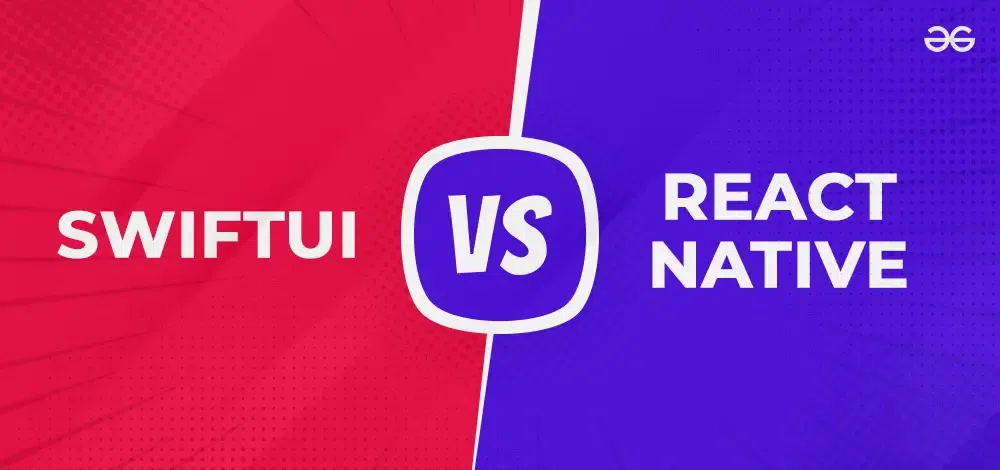Nowadays demand for mobile applications is at a peak and so developers have to make difficult decisions to choose the right platform for their projects. Two striking contenders for this choice are SwiftUI, developed by Apple, and React Native Backed by Facebook. Choosing the correct platform between these two depends on project requirements and specifications. Both platforms have their advantages and limitations. Sometimes a company has budget as the primary factor while sometimes features (where native gives the best performance) act as a primary factor.
Today in this article on SwiftUI vs React Native, we will deep drive in both frameworks and will make it easy for readers to make the correct decision. So, let’s get started.
What is SwiftUI?
SwiftUI, developed by Apple is a modern and declarative UI framework for building user interfaces across various Apple frameworks which include iOS mobile applications, macOS, tvOS, and watchOS. SwiftUI was introduced with iOS 13. It was introduced at Apple’s Worldwide Developers Conference (WWDC) in 2019. SwiftUI allows developers to create interactive and visually appealing user interfaces using a declarative syntax. SwiftUI was mainly designed to make it easy for developers to create rich UI using declarative syntax.
Key Features of SwiftUI
- Native Integration: SwiftUI provides easy integration with Apple’s ecosystem. With SwiftUI developers can build native applications with access to the latest platform features by ensuring consistency and optimized user experience.
- Benefits of Swift language: SwiftUI is built using Swift, an official programming language for the iOS platform. If developers are already aware of Swift language or they have a good grip over Swift then they can switch to SwiftUI more easily.
- Declarative Syntax: Declarative syntax makes iOS UI development more simple. With SwiftUI developers can express UI in a concise and easy-to-read manner. Her users just need to specify what they want rather than how they want.
- Real-time Preview: SwiftUI came up with a very useful feature called Live Preview. So now developers can see live-real time changes while making changes themselves. This can help in quick development and reduce the development cycle. This is a unique advantage compared to some other cross-platform technologies
- Unified Development experience: SwiftUI provides a unified development experience across the various platforms which actually helps developers to reduce development time along with easing the learning curve for developers familiar with Swift language.
Advantages of SwiftUI
- Tight integration with Apple’s ecosystem, provides access to native API, frameworks, and design principles. This ensures the best user experience for Apple users.
- Declarative UI feature, Live Preview can help a lot in reducing development time, as users can see changes live immediately. This is very helpful for rapid development.
- Though Swift UI is mainly developed for the Apple platform it still allows some level of code sharing among iOS, macOS, watchOS, and tvOS. This helps for projects that target multiple Apple devices.
What is React Native?
React native is an Open-Source JavaScript framework that was developed by Facebook in 2015 and it has gained popularity among developers as it also allows the development of cross-platform mobile applications, using React native developers can build cross-platform applications using a single code-base – Write once and deploy it on Android and iOS platforms.
Key Features of React Native
- Cross-Platform Support: React native is mainly developed to support cross-platform development for mobile applications. It allows developers to use a single code base for iOS and Android mobile applications. Which helps in reducing the time and cost of the overall project.
- Combination of React and JavaScript: React native uses Java Script, a widely used programming language, and React, the most popular JavaScript library used for UI building. Developers who are familiar with React and Web development can take advantage of existing skills to build mobile apps.
- Native-like performance: Mobile applications created in react native look like native and give a smoother experience because they use native components that bridge the gap between web and native components.
- Hot reloading: One of the most useful and significant features of react native is reloading, it allows developers to check the result of the latest code changes without re-running the application. Which results in quick debugging and development.
- Large Community: Being a React native developer you can take advantage of large community support. Developed by Facebook, long presence in the mobile development market it has a large developers community that works continuously towards the framework growth.
- Declarative UI(User Interface): React native uses a declarative UI approach, where developers have to describe the required UI, and react native will take care of updating and rendering UI.
- Support for native modules: React native has opened the way for developers to use modules developed in native languages like Java, Objective C, Kotlin, etc. This helps developers to use platform-specific features and good performance experience.
Advantages of React Native
- Mobile applications developed using react native gives native-like performance and developers can use a single code base to build Android and iOS developers.
- The single code base – Multi-platform application build it helps firms to reduce the overall cost of the project.
- A large and Strong community is a strong reason for developers to choose react native as a mobile development platform. Strong library availability helps developers in rapid development.
SwiftUI vs React Native
Let’s closely look at key differences between SwiftUI vs React Native by considering some important aspects.
| Constraints | SwiftUI | React Native |
|---|---|---|
| Platform Support | SwiftUI primarily targets Apple platforms only which include iOS(mobile applications), macOS, watchOS and tvOS. | React native supports cross platform development, It allows Android and iOS application build with a single code base. |
| Community Strength | SwiftUI benefits from Apple’s strong ecosystem and support but still SwiftUI has a community smaller then React native. | Java Script has a very large number of developers which makes the React native community strong. |
| IDE Supports | Apple’s Xcode is a must for development, it also offers other features like live preview, debugging tools etc. | React native projects are developed using multiple IDE like Atom, Visual Studio Code, and Others. |
| Performance | With SwiftUI native code compilations give high performance on Apple platform and direct access to native API leads to better optimization. | React native offers good performance but still, there would be some performance difference compared to the native development. |
| Language | SwiftUI is Written in Swift, Apple’s modern and powerful programming language. Developers who are already skilled with swift can take more advantages. | React Native development uses Java Script and React. Experienced web developers can leverage their existing skills if they want to build mobile applications. |
| Learning Curve | Since its declaration, SwiftUI has received great response from a large number of developers. Swift developers may find it intuitive due to the language consistency. | Easy for developers with back-end development experience. Easy language for newcomers as well as it has easy syntax and terminology. |
Use Cases
SwiftUI
- iOS and macOS Apps: SwiftUI is mainly designed for building apps for Apple’s platforms like iOS, macOS, watchOS and tvOS. For all of these platforms, it provides a unified framework.
- Declarative Syntax: SwiftUI uses a declarative syntax that allows developers to describe UI and its behavior more concisely. This results in readable code that is easy to maintain.
- Performance: Since SwiftUI is a native platform, applications built with SwiftUI give better performance compared with cross-platform technology.
React Native
- Cross-Platform support for Mobile Applications: React native allows the development of cross-platform, which means with a single code base developers can build Android and iOS mobile applications. So, for such requirements, react native is a good choice.
- Rapid development: React native provides Hot-Reload support that helps developers with rapid development and iteration, it also makes it suitable for projects with very strict deadlines.
- Cost-Effective Development: With a single code base react native allows Android and iOS app build, which makes it more cost-efficient. So, with the cost of a single platform, both platform applications can be developed.
- Community and Libraries: React native has a very large community, where developers are working actively to support existing libraries. This vast ecosystem has large numbers of components.
Conclusion
Choosing the correct platform between React Native and SwiftUI is up to your project’s requirements, team’s expertise, and also budget. For cross-platform requirements, React Native is the best choice. If the development team’s background is web development in such cases also react native is a better choice. While for Apple’s device projects where application’s performance is the primary requirement then SwiftUI is always a good choice. If the available developer team has a background in Swift or Objective C then in such cases SwiftUI is a good choice.





